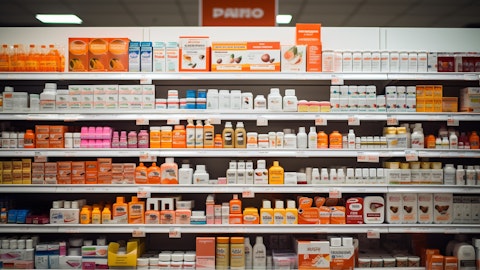Jason Hollar: Nothing to add on that component. As it relates to Red Oak, we feel very good about the scale and competitiveness of that venture — joint venture that we have with CVS. The combined volume that we both bring is sufficient to have significant scale in the space. The percentage of volume that was related to the lost customer is quite small relative to the total that we have that remains. So we feel good about our — continuing our mandate of both continued value for our partners and, ultimately, our customers and as well as the dual mandate aspect of also driving supply as much as possible.
Kevin Caliendo: Thank you, sir.
Matt Sims: Next question, please.
Operator: We’ll now go to Eric Percher, calling from Nephron Research. Please go ahead.
Eric Percher: Thank you. A couple of modest items relative to Pharma that I wanted to tick through. One is, in discussing the headwind, penciling out to $80 million, you used the comment so far once or twice. Is that so far reflecting that there may be more mitigation or that this is influx? That would be one. Number two, is there a contemplation of any incentive comp reduction in ’25 that would then reset in ’26 in that mitigation? And the last one is, Specialty Networks, it sounds like you’re expecting a benefit at the op profit line. I believe the comment when you closed it was it would be accretive 12 months following close. Any commentary on contribution there would be helpful as well. Thank you.
Jason Hollar: Yeah. So I — the so far comment was simply to highlight that we are guiding to at least 1% growth. And so, that reference is entirely around, of course, we continue to look for other opportunities to mitigate further. And depending upon our success with those additional actions will be the answer to your question about incentive comp. We’ll, of course, appropriately define a target with the alignment with our Board to ensure that we are motivated to drive the business forward. And then, as it relates to Specialty Networks, our underlying assumptions are unchanged. The accretive comment was — you’re right, Eric, that the reference point was a year after the close and that was including the dilutive effect on the interest. So, the lost interest on $1 billion, $1.2 billion is the offset to the operating earnings that we see within the Pharma business. So it’s really just the geography of the plus and minus with that.
Aaron Alt: Eric, you had also asked about the impact to compensation plans. And the point I would make is, we set compensation plans on an annual basis for the management teams. And — but we also have a long-term element, which is highlighted in our proxy, the targets there, and we’ll continue to — the teams will be continually motivated to hit those objectives.
Matt Sims: Next question, please.
Operator: Yes, gentlemen. The next question will be coming from Stephanie Davis of Barclays. Please go ahead.
Stephanie Davis: Hey, guys. Thank you for taking my question. You called out a few new wins and expansions in the prepared remarks and you did highlight some customer progress that offsets the Optum headwinds. So I was hoping we can dig in there a little bit more. Can you tell us about the nature of these wins? Is this more core? Is it onc (ph)? Is it other ologies? And how much the bridge from FY ‘25 to the three year guidance relies on further progress with these wins versus more of the streamlining and cost-out that you’ve called out?
Jason Hollar: Yeah. So it’s across various classes of trade. So it’s broad based wins that we’ve received. We are not anticipating needing additional new wins beyond what we’ve already completed or in process of completing. And that’s why when you think about the embedded guidance that we’re talking about in terms of maintaining our long-term targets of that 4% to 6% growth, some years like this year were at the above the high end and next year, it will be a little bit below the low end, but the average is out to that 4% to 6%. And so, it implies a ’26 and beyond type of rate that continues to be in that 4% to 6% range, which is kind of a normal — normalized ongoing type of earnings level. So what — how I step back and think about our progress to date, it really comes down to our service levels and our customer service and really listening to what is important to those customers and working with them for a solution that is not necessarily customized, it is standardized, but with their needs in mind.
And we’re getting fantastic feedback from our current customers in terms of what that service level has been that is translating over to the desire by customers that we’re not working with today to consider using Cardinal Health. And so, we have the time, attention, and energy now that we’re able to devote even more to those existing customers to streamline those processes in a little bit more of a simplified fashion, and we’ll continue to drive that value proposition with those new customers. But it’s very much a booked business type of perspective that we’re now into execution mode. And after this year, fiscal ’25, we’d expect it to be even more normalized at that point.
Aaron Alt: I would add a couple of things to that. First, you asked about cost-out, and my response or our response is that simplification has been a priority of ours for the last couple of years, and we will, of course, continue to go looking for ways we can simplify our operations and optimize our cost. But let me be clear, right, we are not backing away from customer support, particularly the new customers coming onboard, so that we do that seamlessly. And we’re not backing away from investing in our future across our enterprise. And so, we will continue to talk about the highlights of those as we make them in future earnings calls, but we will optimize as appropriate, while focused on the long term.
Operator: Thank you, sir. We’ll now move to Eric Coldwell, calling from Baird. Please go ahead.
Eric Coldwell: Thanks, and good morning. I wanted to talk a bit about specialty in general and then tie in Specialty Networks. So, in the recent past, you’ve given a sizing of your overall specialty business in the low-to-mid $30 billion range. You will lose some of that with the Optum roll off, probably $3.5 billion, $4 billion, I’m guessing. You’re going to add some with Specialty Networks, and then you have normal market growth. So, netting this all together, what would you anticipate the baseline specialty business to be sized at when you start fiscal ’25?
Jason Hollar: So, those are a number of puts and takes that as you noticed, I’m sure, Eric, we did not provide revenue guidance in this update. We will be providing that in the next update, of course. So, certainly, you’re in the ballpark on the Optum piece, as I’ve highlighted before, that is about 10% of that overall book of business. That specialty, everything else would be, PD, non-specialty. And Specialty Networks, the revenue is quite low, because it’s the service revenue, it’s not distribution revenue. So that’s what I would think of independent is that we, of course, would expect our non-Optum specialty revenue to continue to grow nicely and we will frame that, but don’t think about that as something specifically related to Specialty Networks.
Operator: Thank you very much. Next question is coming from Elizabeth Anderson, calling from Evercore. Please go ahead.
Elizabeth Anderson: Hi, guys. Thanks so much for the question. I was hoping you could talk a little bit about — more about GMPD. It seems like the competitive environment maybe is improving in your favor. It seems like maybe there’s some benefit from underlying just like utilization demand. Could you please just give us a little bit more color on sort of those underlying changing dynamics in more — maybe more conceptually and about some of the specific cost-cutting and other inflation offsets that you’ve already talked about?
Jason Hollar: Yeah. I think the competitive environment, I’m not sure I’d put much into that. Our performance within this industry has improved dramatically. I referenced in my comments, the customer loyalty scores improve — have improved consistently and dramatically from the bottom of the pandemic a couple of years ago. So, our performance is noticeable. Our customers are feeling it. That customer loyalty index, the scores behind it improving, because we have — we have the low back order, we have product availability, we have great service levels. We’re very engaged from a sales force perspective. So we’re out there now selling instead of reacting to the challenges of the pandemic. So our customers are feeling that. We have very stable win/loss types of rates.
We’re growing at least with the market now. So it’s more of us showing up, I think, the right way than the market being overly growing more or growing less. The market utilization continues to be more and more normalized. So there’s maybe a little bit of volatility here and there, but it’s much more normalized compared to where it has been in the last several years. So, not — that — and that’s the environment we like. We like to see predictable, consistent lower-single digit type of utilization rates that we can grow a little bit above that through our mix and other actions. And then, of course, as Aaron highlighted, the single biggest driver, not only this past year, but that — what we expect at least in the first half of next year, would be just the lapping of the inflation impacts and everything we’ve done to mitigate that.
Which — that’s another thing that’s helpful for us to get that behind us so that we’re focused on selling and talking to our customers about the value that we can help provide them, as opposed to dealing with inflationary fluctuations that have occurred in the past. So we’re well-positioned to now drive the other elements of the medical — the GMPD Improvement Plan, which is the ongoing simplification, the ongoing cost reductions, but just continuing to really prioritize more than anything the Cardinal Health brand volume growth.
Matt Sims: Next question, please.
Operator: Yes, sir. The next question will be coming from Stephen Baxter, calling from Wells Fargo. Please go ahead.
Stephen Baxter: Hi, thanks. Just one quick confirmation and the actual question. I think what you’re suggesting is that beyond fiscal 2025, there is no direct or indirect impact from the Optum contract loss to contemplate. Just wanted to confirm that point, that there’s not any kind of earnings contribution from a transitional period inside the 2025 thinking. And then the actual question is just on the Other segment. The revenue growth has been quite strong. It’s taken a little bit for the profit growth to kind of catch up to your long-term expectations. Just remind us what the key kind of moving parts are there to accelerate the profit growth in the next couple of years. Thanks.
Aaron Alt: So, an answer to your first question, our guide today does confirm the long-term growth within the Pharma business of 4% to 6%. It will be off a lower base in fiscal ’25 as we grow at least the 1%. We’ve not commented on an absolute dollar basis, but we will provide more context on that when we get to our year end results and final guidance for fiscal ’25 during our August earnings call. With respect to the Other business, we are pleased with what we’re seeing so far. We re-segmented the operation to create additional transparency, focus, and accountability, and I referenced in my prepared remarks that we are already seeing the benefit of that. The topline results are good, right? And we guided 6% to 8% profit growth for this year.
We were a little bit lower than that in Q3 for the businesses aggregating in Other so far. And of course, we had the impact of some of the non-recurring adjustments that we called out in Q2 tied to the at-Home business, which reports into Other in the second quarter. But I want to emphasize, we did confirm that we are expecting to achieve the higher results, the 8% to 10% for fiscal ’24 and we confirm the high end of that range for fiscal ’25, as Jason digs in with the businesses now reporting directly to them and as we invest as an enterprise against setting those businesses up for a higher growth trajectory.
Jason Hollar: Yeah. Just a couple of things to add. First, on the first question, just to be real explicit, given it’s a cliff event customer transition that we are anticipating for July 1, we’d anticipate that that would be largely in fiscal ’25 results and there’s nothing that we’re calling out or indicating at this point that would carry over into ’26. And as it relates to the Other businesses, how I think about them, they’re each growing very nicely. They each have strong industry, strong sectors of the industry that are benefiting from their own individual secular tailwinds. So, they each have different reasons for their growth. But ultimately, it’s because that each of these three areas provide a real interesting value proposition to customers and, ultimately, to the patients.
And each of these three, we have a leadership position in. So we’re not only benefiting from that secular trend, but we’re leading and maintaining or growing our own fair share within it. So we’re well positioned for each one of these three and why we have confidence about them. We are investing into them, as Aaron highlighted. That’s driving the growth that we believe will be driving long-term profitability as well.
Matt Sims: Next question, please.
Operator: Yes, sir. The next question will be coming from Charles Rhyee of TD Cowen. Please go ahead. Your line is open.
Lucas Romanski: Hi. This is Lucas on for Charles. I wanted to ask about Cardinal Health brand and get a sense of where we’re at on the path to realizing $50 million in targeted growth by fiscal ’26. I understand that you’ve expanded the number of products you offer under private label and that you’re starting to see momentum in growing volumes. Can you help us understand how much of that $50 million has already been realized? And then how much we should expect you guys to realize in fiscal ’25? Thanks.
Jason Hollar: Yeah. So I’d — the — it’s a — we inflected a couple of quarters ago, right? You saw that with our overall revenue growth that is partly driven by the Cardinal Health brand volume growth. So we saw, for example, this quarter, our revenue growth of 4% was pro-rated within that national brand, as well as Cardinal Health brand, so, we’re seeing distribution stabilize. We’re seeing that. We’ve won some business there that has allowed us to grow at or a little bit better than the market. So, overall, we’re seeing that this business has now stabilized at a growth consistent with the market. We expect that to continue. This is something that we do have as a component of that growth. As Aaron highlighted, the single biggest driver of profit performance for ’25 — from ’24 to ’25 is the annualization, the carryover of the inflationary pressure.
So that’s the biggest item of that implied $100 million, $110 million year-over-year profit improvement. Then beyond that, you have Cardinal Health brand volume growth, cost reductions, and other actions. And so, it is a component, it’s not the biggest component. And then it would be a — from ’25 to ’26, the primary components that then drive that growth would be Cardinal Health brand volume, as well as further cost reductions as we continue to look to streamline and optimize our footprint, as well as our other supporting cost. So, we’re not going to break out the individual pieces there, but those are the biggest pieces then when you go from ’25 to ’26.
Matt Sims: Next question, please.
Operator: Yes, sir. Our last question today will be coming from Daniel Grosslight of Citi. Please go ahead. Your line is open.
Daniel Grosslight: Hey, guys. Most of my questions have been asked, but I was hoping to just get an update on Navista and any metrics you’re able to share on the market adoption you’re seeing there, number of providers aligned to it, etc. And I know one of the key strategic objectives of the Specialty Networks acquisition was to kind of integrate some of their technology, notably PSS Analytics (ph) into Navista and other specialty assets. I’m also curious if you can provide an update on how quickly you can integrate that technology and Murphy, you’ve already kind of started on that path. Thank you.





